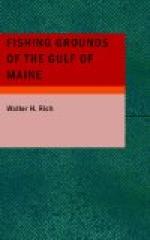The Bay of Fundy is divided at its head by Cape Chignecto, making two branches to north and to east—Chignecto Bay and Minas Basin. With these smaller areas, lying as they do entirely within the territorial limits of Canada, American fishermen have little to do, although both are valuable and productive fishing grounds.
[Footnote 6: William Strachey (1609), speaking particularly of Casco Bay, but the words equally applicable to almost any stretch of the Maine coast, says “A very great bay in which there lyeth soe many islands and soe thick and neere together, that can hardly be discerned the number, yet may any ship pause betwixt, the greatest part of them having seldom lesse water than eight or ten fathoms about them”—History of Travalle into Virginia Britannica.]
[Footnote 7: This, the most striking cape of the Atlantic coast line, made a very prominent landmark for all the early ocean voyagers approaching it, and all were greatly impressed by it, whether they came from the south and fought their way through its shoals to eastward, or, coming from the north, found themselves caught in the deep pocket which it makes with Cape Cod Bay.
The Spaniard Gomez (1525) gave it the name “Cabo de do Aricifes” cape of the reefs, referring to the dangerous shoals to the eastward. The Frenchmen Champlain and Du Monts named it “Cape Blanc”, and the Dutch pilots, also noting its sandy cliffs, called it Witte Hoeck. The English mariners at first accepted his last name of White Cape, but the English Captain Anthony Gosnold, the first to make a direct passage to the waters of the Gulf of Maine from Europe, although at first he called it “Shoal Hope”, soon changed this, because of the success of his fishing, to “Cape Cod”, which title, commonplace though it be, has been the name to endure despite Prince Charles’s attempt to change it to Cape James in honor of his father.]
[Footnote 8: Cape Sable, at the southern end of Nova Scotia, has held this title from very old times. It is so indicated on a Portuguese map of the middle of the sixteenth century.]
BAY OF FUNDY
At the different seasons of the year the entire Bay of Fundy [9] is a fishing ground for sardines and large herring; and while these are of somewhat less importance in recent years than formerly, the principal fisheries of this region still center around the herring industries—the supplying of the canning factories with the small herring used as sardines and the taking of large herring for food and bait. The sardine industry of the State of Maine is largely concentrated in the district about and including Eastport and Lubec, where about 30 of the 59 factories and 16 of the 43 operating firms are located; so that, while the herring catches of recent years have fallen much short of their former proportions, they still show imposing figures.
In the past much of the catch was taken in St. Andrews (Passamaquoddy) Bay and along the north shore of the Bay of Fundy to Lepreau Bay and Point. Lepreau. Of late years virtually no herring have been taken in these waters, in which the herring schools that arrive in October were accustomed to remain until spring. Of past fishing in this locality Capt. Sumner Stuart, of Lubec, says:




